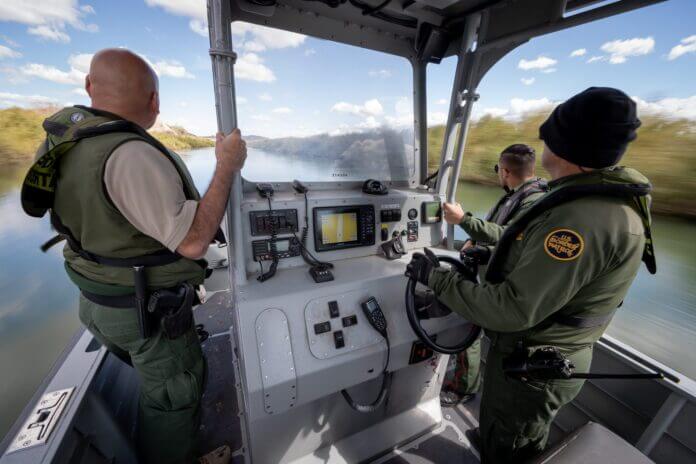As the United States-southern border with Mexico continues to face overwhelming illegal migrant crossings, a new report issued by the U.S. Department of Homeland Security Office (DHS) of the Inspector General (OIG) outlined mistakes that led to the release of an illegal migrant who was on the FBI's Terrorist Watchlist.
The 24-page report, authored by DHS Inspector Joseph V. Cuffari and contains redacted information not available to the public.
According to the report, in April of last year, the suspected terrorist and his family were arrested by Border Patrol in Yuma, Arizona, where agents enacted a national security screening in collaboration with the FBI's Terrorist Screening Center (TSC).
The Bureau found that the migrant was an "inconclusive match" with its Terrorist Watchlist, informing the Customs and Border Protection's (CBP) National Targeting Center (NTC), which is a government entity that uses intelligence and law enforcement information to target and intercept travelers arriving in the homeland, on all forms of transportation, who pose a threat to national security.
The NTC tried to set up an interview with the migrant for additional information by sending the interview request for a specialized on-the-ground CBP team to conduct it.
According to the report, the NTC acknowledged its failure to use the correct email address, resulting in the request not being received by the proper authorities. The CBP entity said this was because of the lack of up-to-date email lists.
The NTC then asked the multi-national intelligence organization to partner with the Mexican government, Grupo Conjunto de Inteligencia Fronteriza (GCIF), to obtain additional information, receiving the requested material from an international source and providing it to the NTC.
The NTC did not send it to the FBI, and according to the DHS Inspector General, officials at the government entity who received the information from the GCIF had no proper excuse for failing to send it.
The NTC then asked the Border Patrol in Yuma, Arizona, for more information from its Central Processing Center to fix the inconclusive match.
While officials received the request and had the material, agents failed to respond, with one saying the mistake was because they were too busy with the high volume of migrant files they had to process.
With all the chaos and confusion, Border Patrol processed the suspected terrorist and released him days after his arrest. According to the Inspector General, Border Patrol provided several reasons for this failure, saying they did not have a proper method to track the suspect’s file when it was labeled an inconclusive match with the Terrorist Watchlist.
Border Patrol added that the Yuma Sector was over capacity, given the surge in illegal immigration and the push to process migrants quickly, resulted in less review time for each file.
The agents released the terror suspect under Immigration Customs Enforcement (ICE) Alternatives to Detention (ATD) program with a GPS ankle bracelet.
Following his release, the suspected terrorist appeared on the U.S. government's radar, where he and his family checked in for flights from different parts of the country, where the Transportation Security Administration (TSA) screened the suspect before boarding to see if he was on the FBI's Terrorist Watchlist. The TSA obtained additional information, confirming he was a positive match to the Terrorist Watchlist.
Following the confirmation of the suspect, the case was sent to ICE and assigned to a specialized Fugitive Operations Team, where agents requested his file but did not receive it due to an eight-day delay.
ICE officials said the delay was because of unprecedented trafficking in Yuma, citing the thousands of files that need to be reviewed, organized, and sent to other parts of the country.
Upon finally receiving the file, Fugitive Operations agents in May arrived at the suspected terrorist's residence in the early morning, waiting for the individual to leave to arrest him. After an hour, several vehicles left the home in Tampa, Florida, with agents contacting local police to confirm the suspect's vehicle.
Agents tried to reach the Tampa ATD office to get the migrant’s information; however, one of their offices was closed, prompting individuals to call a different one, which confirmed their suspicions, leading to an eventual arrest.
The report noted that the confirmation that the suspect was a positive match to the Terrorist Watchlist happened only because the suspect and his family checked in for a flight.
The DHS Inspector General concluded that the failures were caused by the CBP's "ineffective practices and processes for resolving inconclusive matches with the Terrorist Watchlist."
The Inspector General recommended that the DHS create a process to maintain and update Border Patrol email distribution lists regarding NTC information, share best measures to resolve inconclusive matches on the Terrorist Watchlist before releasing suspected migrants, and enact a process that would allow ICE officers to have instant availability to GPS data relevant to law enforcement operations.
Despite the report and its shocking contents, experts say these situations will continue if the Biden administration does not seriously confront the ongoing immigration crisis at the southern border.
Related Story: Alert: Six Border Crossers on Terror Watchlist Apprehended in 72 Hours










